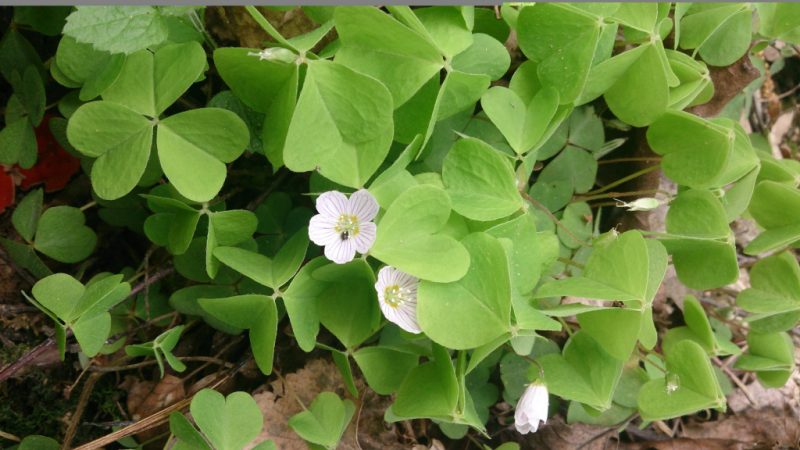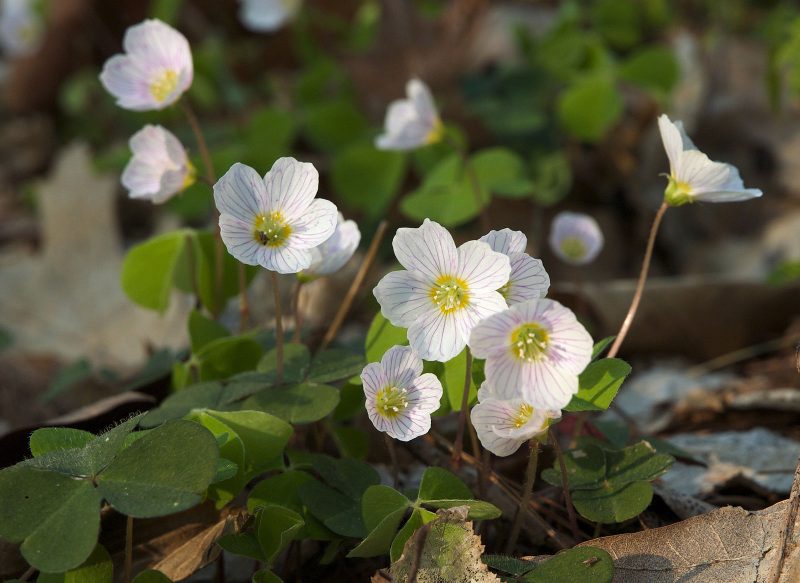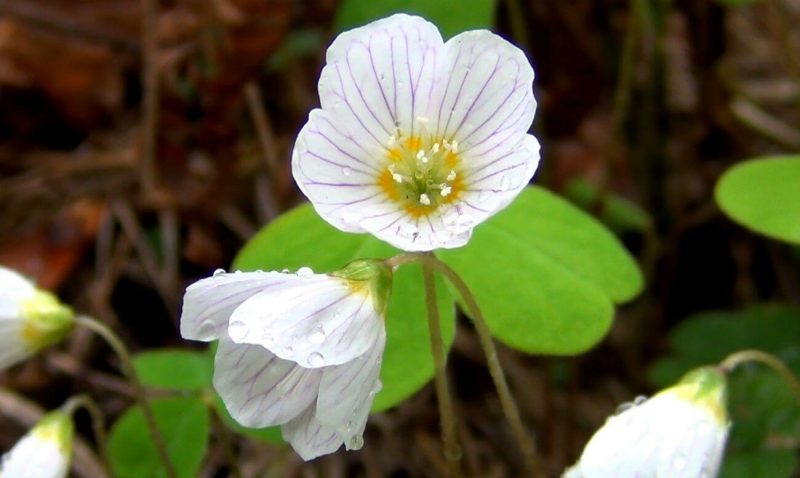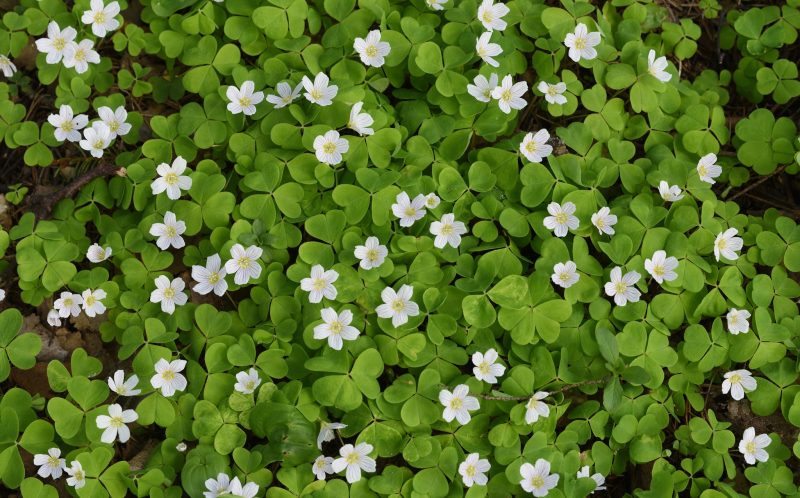Common Oxalis is a delicate and beautiful plant with leaves similar to butterfly wings. She feels great in the garden, on a shady area between the trees, on a well-lit lawn and in a flower pot on the windowsill. The plant is unpretentious in care and very useful, it can be used to treat various diseases.
Material Content:
Grade description
Kislitsa belongs to the Sorrel family, it is grown on the street and in the room. Breeders bred interesting decorative varieties with purple and burgundy leaves, flowers of different colors.

The common sour plant is a short (up to 10 cm) perennial with small white flowers that bloom from May to June. It has a long creeping rhizome on which mushrooms live. The resulting mycorrhiza looks like small nodules or swelling on the roots.
Long leaves are composed of three parts. They are somewhat reminiscent of clover, but, unlike him, have a solid green color without a bright middle. The organic acids contained in them give a special, pleasant aftertaste to the leaves. Such grass, consumed in large quantities, can cause irritation of the urinary system.
In decorative floriculture, such varieties are popular:
- Ferruginous acid. Gray-green leaves, a thick brown tuber looks like a shaggy bulb.
- Ortgisa. The ternate leaves are brown-red, the flowers are yellow.
- Kislitsa Depp. Lilac flowers with a yellow core. A feature of the species is green leaves with a burgundy spot in the center, consisting of 4 parts, due to which the plant is called the clover of good luck.
- Cupped. Green tripartite leaves. Dark pink flowers bloom in summer.The plant is perennial, growing from tubers, similar to bulbs.
- Purple acid. Rounded triple leaves and pink flowers.
- Regnella, or triangular. A beautiful variety with purple leaves and snow-white or pinkish flowers.
A characteristic feature of the plant is that it, like a moth, folds the leaves at dusk or if the sun hides behind the clouds on inclement days. When morning comes, the leaves straighten and stretch towards the light.
In addition to decorative value, acid has a lot of useful properties. In traditional medicine, it is used as a wound healing and hemostatic agent, as a diuretic, anthelmintic medicine, as well as for the treatment of scurvy and ulcers.
Acid juice has an antimicrobial effect, the leaves can be chewed with gum disease and oral mucosa. The special ability of a plant to neutralize arsenic and mercury poisons is known.
Leaves are also used in cooking - they make delicious tea that contains many vitamins, add to kvass, cabbage soup and egg dishes. However, prolonged use of a plant for food can cause kidney disease.
Where does sour acid grow in Russia
The plant is common in the European part of the country, in the vastness of Siberia, the Far East and the Caucasus. It can easily be found in coniferous forests. The shade glades of the spruce forest cover the whole acidic layer, triple green leaves grow on long petioles directly from the ground.

When grown from seeds, the plant develops well in the light. Natural shading is more a fixture than a necessity. In the garden, sour acid can be planted on a shady flower bed between tall trees or bushes and on the sunny side, where flowering in summer will be more plentiful.
Features of the cultivation of common acid

- The optimum temperature for growing is 20 - 25 ° C, and during dormancy - 12 - 18 ° C. The plant loves plentiful watering in the summer and moderate in autumn and winter.
- The plant loves high humidity, because in the summer the leaves are sprayed daily. If the humidity in the room is about 50%, the plant can do without spraying.
- When grown in summer in open ground, the grass is watered twice a day - in the morning and in the evening.
From mid-spring to the end of summer, the acid is fed with a complex fertilizer for indoor plants once a week, making the solution a weak concentration.
Outdoor landing
In the summer, the sour feels great in the garden. It is transplanted by transshipment, well after watering the earth in a pot well. The root system of the sour is weak, brown nodules are visible on the thin roots.

After transplanting, the acidic does not need to be watered often. She does not like stagnation of water, so the soil should be quite loose. When planting in heavy clay soil, sand, peat and turf ground are added in equal parts. If the soil in the garden is loose and light, with an acid reaction, the plant will grow well.
On the flower bed, the distance between the bushes is 20 or 30 cm. The sod is planted after 3 or 4 years in August or September. The plant spreads vegetatively, underground shoots, and can occupy a significant area. This should be considered when choosing a place for landing.
Oxygen Care Tips
When grown in a room, the plant feels good in low, but wide pots. May bloom year round or drop leaves for winter.

- The sour is placed in a well-lit place, but the light should be scattered, because the leaves are injured under the direct influence of the sun, begin to burn, lose their decorative effect.
- An adult plant is transplanted once every 2 years, and a young plant every year. At the same time, the root is deepened by only 2 cm - the sour acid does not like a deep landing.
- If the plant discards leaves or stops flowering, it must be given rest time and put in a cool room. During dormancy, watering is reduced to a minimum.
When grown in the garden, sourness does not cause much trouble.It itself grows beautifully, forming thick sods, does not require renewal after wintering.
Perennial rhizomes tolerate frosts well even without shelter. Sometimes rapid plant growth can be a problem, since seed bolls crack in the fall, scattering seeds over long distances. For this reason, it is advisable to plant sour acid away from vegetable beds and flower beds. The best place for her is in the garden under the trees.
Methods of propagation of a herbaceous plant
Oxalis propagates by self-seeding or vegetatively by dividing the bush, nodules and cuttings. When transplanting the plant is divided into separate bushes, planting them in a flower bed or in separate flower pots.

It is possible to plant sour acidum in the fall and in the spring. At room conditions, nodules begin to germinate in March of 5 to 8 pieces in one pot, a centimeter layer of earth is poured on top.
Pest and Disease Treatment
When waterlogged on the plant, rot may appear. For treatment using the drug "Fundazole".

Oxygen is rarely affected by pests, but sometimes a tick or aphid settles on the leaves. To combat insects using folk methods - 1 tbsp. a spoon of soap is bred in 1 tbsp. water and spray the bushes. In severe cases, the natural insecticide Fitoverm will be used.
Kislitsy - unpretentious herbaceous plants for open ground, which can be grown not only in the garden, but also on the windowsill in the apartment. Decorative varieties with colored leaves and delicate flowers on long peduncles are especially good. The main condition for good acidity growth is planting in loose soil and plentiful summer watering.












